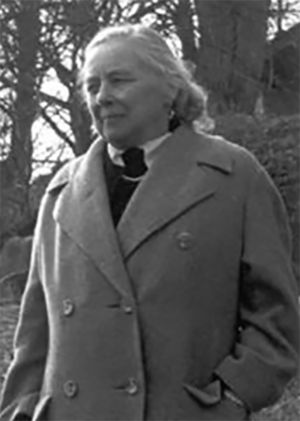Johanna Countess Keyserlingk

Johanna Countess Keyserlingk, née Skene von Skene on *26 March 1879 in Breslau (then Germany) died on †16 March 1966 in Teinach, Black Forest (Germany). She was a landowner and anthroposophist.
Johanna von Keyserlingk had clairvoyant abilities and often discussed the results of her spiritual research with Rudolf Steiner. She hosted the agriculture course Whitsun 1924 at Koberwitz Castle near Breslau. From then on, this Whitsun festival remained the focal point of her destiny. She often hosted anthroposophical friends in her hospitable house.
Johanna von Keyserlingk came from the Scottish noble family of the Skene of Skene. Rudolf Steiner called her clairvoyance "the blessing of the clan". According to Steiner, Scottish clairvoyance was free of Lucifer, Monica von Miltitz, a friend of Johanna's, said in her congratulations (Miltitz 1959). Johanna was the only Skene of her generation who possessed this gift. - Karl von Skene, the very dominant father, had emigrated from Scotland; first he settled in Austria, later in Silesia. His mother Klara (née Schoeller) came from an industrialist family in the Rhineland. Karl von Skene was on the supervisory board of the family business Vom Rath, Schöller & Skene AG (agriculture and sugar industry).
Johanna spent her childhood in Breslau as the third child among three brothers. Early on, she noticed her gift for perceiving events in advance. However, she was not understood for her spiritual perceptions and could not talk about them with anyone. In her youth, she studied astronomy and Kant's philosophy, later Angelus Silesius and Hölderlin. Already as a child she had met Rudolf Steiner several times - without knowing him; he later reminded her of their first encounter - on a walk in the Vienna Woods.
On 21 January 1899 Johanna married Carl Wilhelm Count Keyserlingk. She gave birth to three sons, one of whom died soon after birth. The family lived in Klettendorf near Breslau, where the seat of the family business was, in which her husband now worked. - In 1907 she had to endure a serious illness which brought her to the point of death. Serious late effects still occurred years later. Johanna, who had been searching for orientation with her soul for years, had already read Rudolf Steiner's writings before 1916 and wrote him a letter in 1916, which, however, did not reach him. The overwhelming first encounter, which was tantamount to a turning point in her life, took place in 1918 in Berlin at the home of Eliza Gräfin von Moltke. In a long conversation, she was able to discuss with him important stages of her life up to that point, including near-death and death experiences, and in particular her profound spiritual perceptions that reached back to the first year of her life. He then gave her exercises to clarify certain issues related to her perceptions. However, he did not ask her to transform her clairvoyance. Finally, he encouraged her to write down her experiences. Her consciousness was as it would be in the third millennium. Johanna became Steiner's esoteric disciple, receiving personal instruction on several days. Her husband also joins Steiner after his first encounter.
In 1920 the family moves to the Koberwitz estate - thanks to Rudolf Steiner's decisive advocacy, even intervention ("Ask for Koberwitz!"). Karl and Johanna turned the castle belonging to the estate into a hospitable place with a cosmopolitan touch, which accommodated, among others, the founding priest of the Breslau congregation of the Christian Community Rudolf Meyer for three years. The first human consecration in Silesia was celebrated in Koberwitz. Meyer remained closely associated with the Countess throughout her life, and she entrusted him with much of her spiritual research, including her experiences of the Christ, about which she had spoken with Rudolf Steiner. The solemn climax of the short time in Koberwitz (in 1928 the Keyserlingks had to move to Sasterhausen) was the agriculture course at Whitsun 1924. For Johanna, these 12 days were filled - among many other things - with further esoteric teaching talks with Rudolf Steiner. Much of the 28 conversations they had is recorded in their publications (most of which were published posthumously by their son Adalbert Count Keyserlingk). Rudolf Steiner - despite the intimate nature of many of these communications - did not object to her talking about them. Topics of these conversations included Kaspar Hauser, Hölderlin, the Earth's interior, Shambhala and, again and again, the Christ.
In 1928 her husband died. In 1941 Johanna was arrested by the Gestapo and interrogated for days. - After the end of the war in 1945, she reluctantly left Silesia; penniless and incognito, she escaped to West Germany. In Stuttgart she lived in modest circumstances. Her first publication ("Zwölf Tage um Rudolf Steiner") appeared in 1949 as a private print. She shared confidential information from her conversations with Steiner with many friends, including Emil Bock and Margarita Woloschina, while she was still alive. In the years before her death she had to "experience the whole weakness and frailty of physical corporeality" (Meyer 1966). She spent her last years in a nursing home near Teinach in the Black Forest, where she also died.
Literature
- Koberwitz 1924. Geburtsstunde einer neuen Landwirtschaft, edited by Adalbert Count Keyserlingk, Verlag Hilfswerk Elisabeth, Stuttgart 1974
